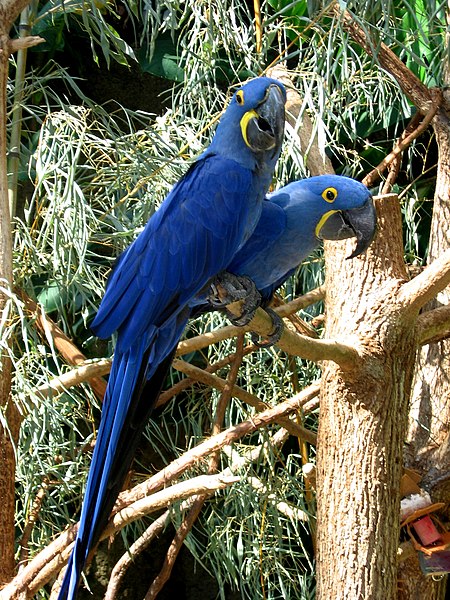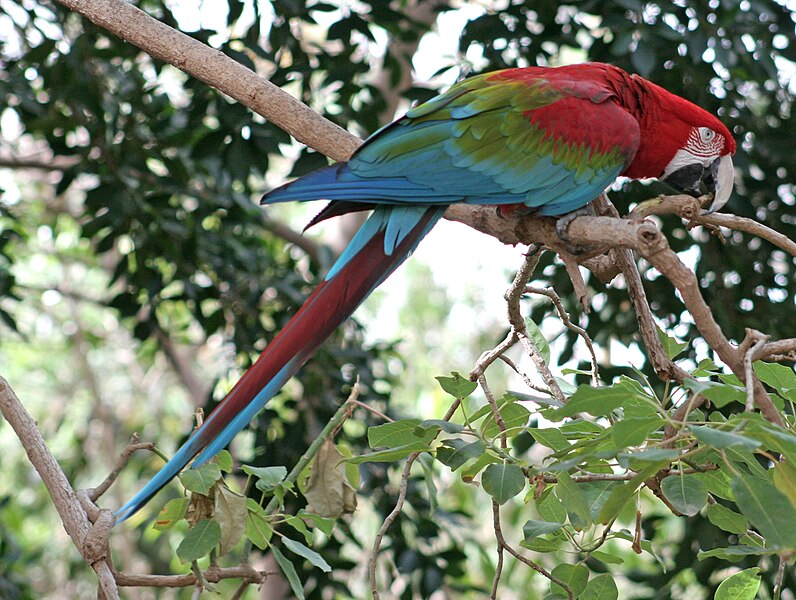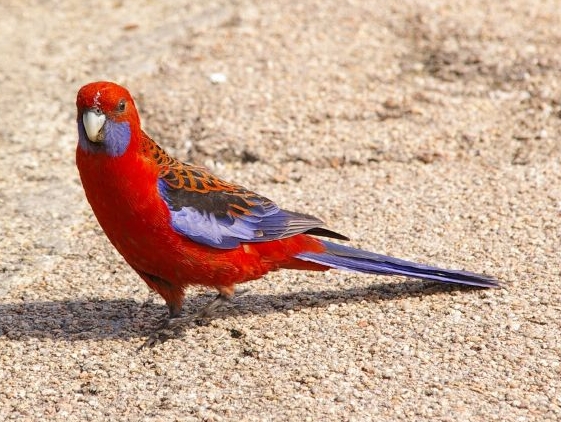Please see Part I of this article for information concerning macaws in general and the noble or red-shouldered macaw in particular. Last time I left off with an account of the smallest macaw…I begin here with the largest.
Hyacinth Macaw, Anodorhynchus hyacinthinus
 At 40 inches in length and sporting a wingspan of nearly 5 feet, this giant of the group is also the world’s largest parrot. Words cannot do justice to its plumage, which is deep cobalt blue in color, highlighted by golden yellow about the eyes and lower mandible.
At 40 inches in length and sporting a wingspan of nearly 5 feet, this giant of the group is also the world’s largest parrot. Words cannot do justice to its plumage, which is deep cobalt blue in color, highlighted by golden yellow about the eyes and lower mandible.
Hyacinths are largely confined to southern Brazil, with sporadic records from western Bolivia. They favor stands of buriti palms, the nuts of which form a large portion of their diet, and forage mostly in the higher branches. Hyacinth macaws also frequent open forests along waterways near and within Brazil’s Pantanal region.
Although these spectacular birds are not for those lacking large parrot experience (or cash!), they are considered to be among the most gentle and affectionate of the macaws. Hyacinths are, however, extremely protective of those to whom they have bonded, and wary of strangers. They will not hesitate to use their massive beaks when a threat is perceived, and must be handled accordingly.
Blue-and-Gold Macaw, Ara ararauna
 Although smaller than the hyacinth, this 3 foot-long beauty is still quite an impressive bird. With its particularly affectionate personality, playful ways and impressive speaking ability, the blue-and-gold is perhaps the best of the large macaws with which to start. Huge imports in the 1960’s and 70’s allowed the establishment of many breeding groups, and today it is the least expensive and most widely-kept macaw in the USA.
Although smaller than the hyacinth, this 3 foot-long beauty is still quite an impressive bird. With its particularly affectionate personality, playful ways and impressive speaking ability, the blue-and-gold is perhaps the best of the large macaws with which to start. Huge imports in the 1960’s and 70’s allowed the establishment of many breeding groups, and today it is the least expensive and most widely-kept macaw in the USA.
Colored in turquoise-blue offset by a brilliant golden-yellow chest, blue-and-gold macaws are sometimes seen in large flocks, within which the pairs stay in close contact. Indeed, even upon my first sighting of them in the wild (when I could hardly think straight, so impressed was I by their size and brilliance!), pairs were readily discernable within each flock.
This species is declining in many areas, but still occupies a huge swath of land from eastern Panama and French Guiana in the north to Bolivia in the south. Flocks forage widely along savannahs, forest edges and swamps, returning at dusk to favored roosting sites. The blue-and-gold is one of the few macaws that can be counted upon to show up on a well-planned birding trip to prime habitat…I guarantee that a sighting will be remembered for a lifetime.
Green-winged Macaw, Ara chloroptera
 Often mistaken for a scarlet macaw, the green-wing is a larger bird, nearly the size of a hyacinth, and is clad in a deeper burgundy red than is its more commonly-kept cousin. It is also an easier bird to manage than the scarlet, being quite gentle and very playful. My first long-ago experience with hand raised green-wings remains sharp today…rolling on their backs and pawing at me, they acted more like kittens than birds! Green wings are, however, very sensitive birds, and are easily upset by strangers or sudden noises. Their beaks are out-sized, even by macaw standards, and lend them a comical air.
Often mistaken for a scarlet macaw, the green-wing is a larger bird, nearly the size of a hyacinth, and is clad in a deeper burgundy red than is its more commonly-kept cousin. It is also an easier bird to manage than the scarlet, being quite gentle and very playful. My first long-ago experience with hand raised green-wings remains sharp today…rolling on their backs and pawing at me, they acted more like kittens than birds! Green wings are, however, very sensitive birds, and are easily upset by strangers or sudden noises. Their beaks are out-sized, even by macaw standards, and lend them a comical air.
The range of the green-winged macaw closely parallels that of the blue-and-gold (please see above), but it is much more of a true forest bird than its relative. Green wings favor hilly country, and are rarely observed far from heavy tree cover. When foraging and roosting, they stay to the treetops. Interestingly, green wings hybridize with both military and blue-and-gold macaws in the wild.
A look at a few moderately-sized macaws next time will round out our survey.
You can read about World Wildlife Fund’s work with hyacinth macaws in the Brazilian Pantanal at:
http://www.panda.org/about_wwf/what_we_do/species/news/species_successes/index.cfm?uNewsID=12641
Hyacinch Macaw images and Green-Winged Macaw Images referenced from Wikipedia Commons
 That Bird Blog – Bird Care and History for Pet Birds
That Bird Blog – Bird Care and History for Pet Birds

 Crimson rosellas, colorful parrots much favored as pets, follow a unique strategy when rearing their young.
Crimson rosellas, colorful parrots much favored as pets, follow a unique strategy when rearing their young.